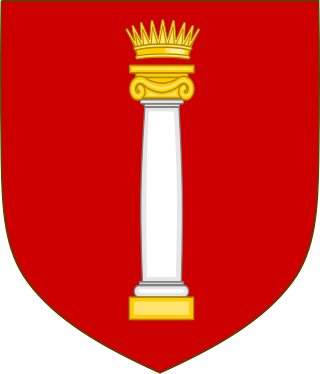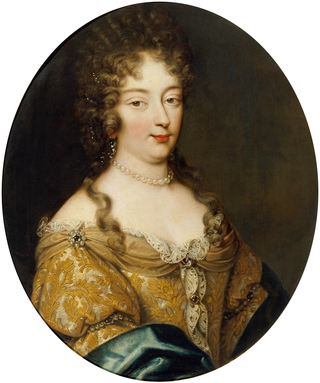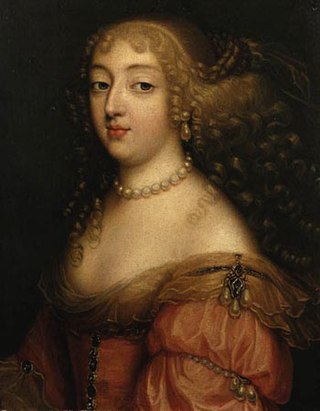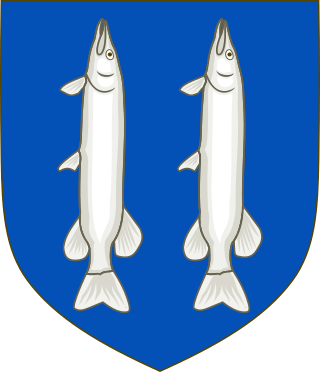
Lorenzo Onofrio Colonna (1637–1689) was an Italian nobleman of the Colonna family. He was the 8th Duke and Prince of Paliano and hereditary Grand Constable of the Kingdom of Naples. He was also a Knight of the Golden Fleece.

Lorenzo Onofrio Colonna (1637–1689) was an Italian nobleman of the Colonna family. He was the 8th Duke and Prince of Paliano and hereditary Grand Constable of the Kingdom of Naples. He was also a Knight of the Golden Fleece.
Colonna was born in Rome, the son of Marcantonio V Colonna, Prince of Paliano and Isabella Gioeni Cardona, Princess of Castiglione. He was the nephew of Anna Colonna who married Taddeo Barberini, Prince of Palestrina. He was inducted into the Order of the Golden Fleece in the same year as his cousin, Maffeo Barberini.

In 1661 he married Maria Mancini, a niece of Cardinal Mazarin. [1] She was the first love of Louis XIV whose desire to marry her caused his mother, Anne of Austria, and Maria's uncle intense concern. The relationship between Maria and Louis was an idealistic one, and remained unconsummated. Colonna remarked after their wedding night that he was surprised to find her still a virgin, famously stating that had not expected to find "innocence among the loves of kings." [2]
He and his wife became great patrons of the arts, and exercised influence in the cultural and political spheres of Rome and Italy. Many artists such as Nicolò Minato and Francesco Cavalli dedicated works to the Colonnas. [3] Despite Colonna's prestigious French marriage, the Colonna family was generally aligned with Spanish interests in Italy. The family's rivals in Rome, the Orsini and Barberini were French partisans.
After the birth of their third son, relations between Colonna and his wife deteriorated for multiple reasons, including his infidelities and her fears of further childbirth. [4]
On 29 May 1672, fearing that her husband would kill her, Mancini left Rome accompanied by her sister Hortense Mancini. She did not return to Italy until her husband's death in 1689.
Between 1678 and 1681, Colonna was appointed Viceroy of Aragon, in Spain.
Lorenzo Onofrio Colonna and Maria Mancini had three children:
Colonna also had two children by the Countess Ortensia Stella whom he acknowledged in his will. [5]

The House of Colonna, also known as Sciarrillo or Sciarra, is an Italian noble family, forming part of the papal nobility. It was powerful in medieval and Renaissance Rome, supplying one pope and many other church and political leaders. The family is notable for its bitter feud with the Orsini family over influence in Rome, until it was stopped by papal bull in 1511. In 1571, the heads of both families married nieces of Pope Sixtus V. Thereafter, historians recorded that "no peace had been concluded between the princes of Christendom, in which they had not been included by name".

Hortense Mancini, Duchess of Mazarin, was a niece of Cardinal Mazarin, chief minister of France, and a mistress of Charles II, King of England, Scotland, and Ireland. She was the fourth of the five famous Mancini sisters, who, along with two of their female Martinozzi cousins, were known at the court of King Louis XIV of France as the Mazarinettes.

Olympia Mancini, Countess of Soissons was the second-eldest of the five celebrated Mancini sisters, who along with two of their female Martinozzi cousins, were known at the court of King Louis XIV of France as the Mazarinettes because their uncle was Louis XIV's chief minister, Cardinal Mazarin. Olympia was later to become the mother of the famous Austrian general Prince Eugene of Savoy. She also involved herself in various court intrigues including the notorious Affair of the Poisons, which led to her expulsion from France.

Laura Mancini, Duchess of Mercœur was a niece of Cardinal Mazarin. She was the eldest of the five famous Mancini sisters, who along with two of their female Martinozzi cousins, were known at the court of Louis XIV of France as the Mazarinettes. She married Louis de Bourbon, Duke of Vendôme, grandson of King Henry IV and was the mother of the great general the Duke of Vendôme.

Marie Anne Mancini, Duchess of Bouillon, was an Italian-French aristocrat and cultural patron, the youngest of the five famous Mancini sisters, who along with two of their female Martinozzi cousins, were known at the court of Louis XIV, King of France as the Mazarinettes, because their uncle was the king's chief minister, Cardinal Mazarin. She is known for her involvement in the famous Affair of the Poisons, and as the patron of La Fontaine.

Anna Maria "Marie" Mancini, Princess of Paliano was the third of the five Mancini sisters, nieces to Cardinal Mazarin who were brought to France to marry advantageously. Along with two of their female Martinozzi cousins, the Mancini sisters were known at the court of King Louis XIV of France as the Mazarinettes. Marie is an ancestor of Queen Paola of Belgium.

Filippo II Colonna was an Italian nobleman of prominent Colonna family. He was the 9th Duke and Prince of Paliano.
Filippo Colonna, 6th Prince of Paliano, Prince of Paliano, was an Italian nobleman, who was the head of the Colonna family of Rome and the hereditary Gran Connestabile at the court of Naples.

The title Duke and Prince of Paliano is borne by the head of the elder line of the Colonna family. At times the honour has been borne by several members at once. The Princes also bear many other titles and honorifics.

The House of Mancini was the name of one of the oldest families of Roman nobility. Their titles and fiefs were numerous: Duke of Nevers and Donzy, Prince of Vergagne and of the Holy Roman Empire with the treatment of Serene Highness, French Peer, Spanish Grandee, Marquis of Fusignano, Count of Montefortino, Viscount of Clamecy, Baron of Tardello, Tumminii and Ogliastro, Lord of Claye-Souilly, Roman noble and Venetian patrician.

Francesco Maria Mancini was an Italian cardinal of the Mancini family. He was made a cardinal by Pope Alexander VII, in reward for contributing to Alexander's election as pope.
Girolama or Geronima Mazarini was the sister of Cardinal Mazarin, the chief minister of France at the start of the reign of King Louis XIV of France. She was the mother of the five famous Mancini sisters, who with two of their female Martinozzi cousins, became famous at the French court as the Mazarinettes.

Philippe Jules Mancini, 8th Duke of Nevers (1641–1707) was the nephew of Cardinal Mazarin, chief minister of France immediately after the death of King Louis XIII. He was the brother of the five famous Mancini sisters, who, along with two of their female Martinozzi cousins, were known at the court of King Louis XIV of France as the Mazarinettes.

The Mazarinettes were the seven nieces of Cardinal Jules Mazarin, (1639–1661), chief minister to the Kings Louis XIII and Louis XIV of France from 1642 until his death.

Lucrezia Barberini was an Italian noblewoman and, by marriage, Duchess of Modena. Born into the Barberini family, she was the last wife of Francesco I d'Este, Duke of Modena.

Anna Colonna (1601–1658) was an Italian noblewoman of the Colonna and Barberini families. She was also the Princess of Paliano.

Marcantonio Colonna, 7th Prince of Paliano was an Italian nobleman of the Colonna family and 7th Prince of Paliano.

Louis d'Ogier, or d'Augier, Marquis de Cavoye was a French aristocrat, childhood friend of King Louis XIV and Grand Marshall of the Royal Household at Versailles.
Vittoria Colonna Caetani, Duchess of Sermoneta was an Italian writer, best known for her Memorie, translated into English as Things Past (1929).

Carlo Colonna was a Roman Catholic cardinal.